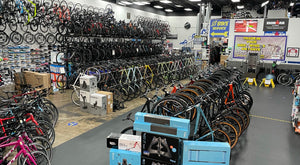
THE SHORT COURSE ~ BIKE FOCUS

On my short course journey, I was reminded of really how great sprint & Olympic distance triathletes can ride a bike.
Just like the swim, from the moment they leave the bike rack, hustle to the mount line, leap (and I do mean leap for many of them) onto their bikes, and head out to tackle the course- it's no joke- they are moving and you learn to find your next gear in short course.
Here are a few bike details that short course athletes have mastered. Plus skills and drills to implement in your workouts.
THE TRANSITION
Bottom line, these guys/gals are lightning FAST! At Nationals / World's we have had both ourselves and/or clients hit or miss the podium due to the efficiency of transitions. Short course athletes know that the simple set up is key, you are NOT creating 'a residence' in transition.
Workout Skill/ Drill to Implement in Training:
Practice transitions! Practice the setup and the execution both 'from the water' and 'to the run'. To take it up a notch practice not only when you are fresh, but I love challenging athletes to do this as part of their warm down.
The safest and most effective way to work on your swim-bike transition is to start with your shoes on the bike.
AGAIN, you will NEED to practice setting up the bike with our shoes attached (my preference is to use rubber bands), navigating the bike from the saddle, and how AND where you want to mount the bike. Don't worry, you do not have to 'hurl' your body onto the bike- but you need to leave time in your training to focus and dial in how you want to attack your transitions.
BIKE HANDLING AND CORNERING
Maybe the worst habits I see in long course athletes are a.) they don't focus on minimizing side to side movement, resulting in wasted energy, not to mention taking away their forward progression (aka adding time to the clock) b.) they forget bike handling 101 and simply glide through a corner only to hammer like all-get-out on the back half, wasting significant time and energy.
Workout Skill/ Drill to Implement in Training:
I say to my clients all the time- even if it is an easy recover spin, "Watch your line and practice proper cornering. If you can train your body to do it every time you head out to train, come race day it will be automatic." So two things you can practice, every time you are on the bike:
a.) Simply glance out in front of you, primarily look 6 feet out in front of your wheel and keep your chin down to minimize the neck strain.
b.) Try and hold your wheel parallel with the lane line on the road. If you find yourself weaving back and forth, you are most likely loosing precious seconds and wasting a lot of energy on race day with your lack of bike control. With attention to this detail, you will see that this is a quick fix. Long course athletes are just accustomed to logging long miles. Many times they not focused on the small details of bike handling that can really benefit the athlete.
c.) I could go on and on about cornering. But for now, I want to focus on shifting and powering out of a corner. When coming through corners, make sure you are not in your hardest gear- otherwise, you are going to have to hammer fest your way out of there and lose valuable energy for later in the race. While not being in the hardest gear, whether sitting or standing once you are cresting the corner, increase your cadence and then shift into a harder gear only after you have regained momentum. Do this in every ride- you will not only gain speed quickly, but you will be able to SUSTAIN that effort coming out of corners.
LEGAL DRAFTING
"Drafting"- it's the cuss word that everyone hates in non-draft legal triathlon. Have even heard it called comparable to doping. Here is the gig, there is something called LEGAL drafting when passing or being passed by an athlete. In short course, you have ~15sec to pass or drop back if you are being passed. The difference in long course and short course, long course athletes (unless just deliberately sucking some one's wheel) typically do not utilize a slipstream approach when moving throughout the course.
AGAIN, I am not encouraging you to hang on the back of another athlete's wheel. Instead, when passing another cyclist, learn to approach from directly behind them rather than automatically moving to the left and trying to make a point as you grind right by them. Get in their slipstream and then move to their front wheel.
Workout Skill/ Drill to Implement in Training:
Head out with either a small group or an area where there are plenty of riders (aka: opportunities to practice legal drafting).
When I go out with a client, we focus on both passing and being passed by another rider. Both times, we focus on moving either forward or sitting back into the other riders slipstream or ~10sec and then learning to drop back within ~5sec in order to ensure we are not in danger of other athletes or ignoring the rules.
The draft legal zone is 3 bike lengths- What does 3 bike lengths look like?
A way to measure the legal distance from your position to the lead rider is by using the white or yellow separator lines on the road (if available).
One line = ~3m long (and the distance between the lines is about 9 meters if you want a further reference). Therefore, you only need one white/yellow line and an extra 4-5 feet of space beyond that between your front wheel and the leader’s rear wheel to avoid a drafting penalty.
Practice both passing and dropping back- to keep it super simple:
If you passed 10 people x 10 sec/person of legal drafting and then 5 people happened to pass you x 10sec/person of legal drafting= that's over 2.5 min of 'drafting' and utilizing others to get you to the finish line faster.
Short course athletes know the value of practicing and implementing fast transitions, proper handling & cornering ~ keep practicing!
Continue to train with a smile~
Author: Amari Holmes



